Motivation and Sense of Belonging in the Large Enrollment Introductory General and Organic Chemistry Remote Courses
Abstract
:1. Introduction
- Research Question 1: To what extent are statistical differences observed with academic standing and motivation or sense of belonging?
- Research Question 2: To what extent are statistical differences observed with first-generation status and motivation or sense of belonging?
- Research Question 3: To what extent are statistical differences observed with gender and motivation or sense of belonging?
- Research Question 4: To what extent statistical differences observed with race/ethnicity and motivation or sense of belonging?
- Research Question 5: What are the advantages and disadvantages of remote learning?
2. Materials and Methods
- a.
- Participants
- b.
- Survey Design
- c.
- Data Collection
- d.
- Data Analysis
- e.
- Reliability Coefficients
3. Results
3.1. Correlations with Student Motivation
3.1.1. Academic Standing and Motivation
3.1.2. First-Generation Status, Gender, and Motivation
3.1.3. Ethnicity and Motivation
3.2. Correlations and Sense of Belonging
3.2.1. Academic Standing and Sense of Belonging
3.2.2. First-Generation Status and Sense of Belonging
3.2.3. Ethnicity and Sense of Belonging
3.3. Pros and Cons of Online Learning
4. Discussion
5. Conclusions
Supplementary Materials
Author Contributions
Funding
Institutional Review Board Statement
Informed Consent Statement
Data Availability Statement
Acknowledgments
Conflicts of Interest
References
- Andrews, J.L.; de Los Rios, J.P.; Rayaluru, M.; Lee, S.; Mai, L.; Schusser, A.; Mak, C.H. Experimenting with at-home general chemistry laboratories during the covid-19 pandemic. J. Chem. Educ. 2020, 97, 1887–1894. [Google Scholar] [CrossRef]
- Karayilan, M.; Vakil, J.; Fowler, D.; Becker, M.L.; Cox, C.T., Jr. Zooming in on Polymer Chemistry and Designing Synthesis of High Sulfur-Content Polymers for Virtual Undergraduate Laboratory Experiment. J. Chem. Educ. 2021, 98, 2062–2073. [Google Scholar] [CrossRef]
- Campbell, C.D.; Challen, B.; Turner, K.L.; Stewart, M.I. # DryLabs20: A new global collaborative network to consider and address the challenges of laboratory teaching with the challenges of COVID-19. J. Chem. Educ. 2020, 97, 3023–3027. [Google Scholar]
- Buchberger, A.R.; Evans, T.; Doolittle, P. Analytical Chemistry Online? Lessons Learned from Transitioning a Project Lab Online Due to COVID-19. J. Chem. Educ. 2020, 97, 2976–2980. [Google Scholar] [CrossRef]
- Dunnagan, C.L.; Gallardo-Williams, M.T. Overcoming physical separation during COVID-19 using virtual reality in organic chemistry laboratories. J. Chem. Educ. 2020, 97, 3060–3063. [Google Scholar] [CrossRef]
- Prince, M.; Felder, R.; Brent, R. Active student engagement in online STEM classes: Approaches and recommendations. Adv. Eng. Educ. 2020, 8, 1–25. [Google Scholar]
- Lowenthal, P.; Borup, J.; West, R.; Archambault, L. Thinking beyond Zoom: Using asynchronous video to maintain connection and engagement during the COVID-19 pandemic. J. Technol. Teach. Educ. 2020, 28, 383–391. [Google Scholar]
- Venton, B.J.; Pompano, R.R. Strategies for Enhancing Remote Student Engagement through Active Learning; Springer: Berlin/Heidelberg, Germany, 2021. [Google Scholar]
- Perets, E.A.; Chabeda, D.; Gong, A.Z.; Huang, X.; Fung, T.S.; Ng, K.Y.; Bathgate, M.; Yan, E.C. Impact of the emergency transition to remote teaching on student engagement in a non-STEM undergraduate chemistry course in the time of COVID-19. J. Chem. Educ. 2020, 97, 2439–2447. [Google Scholar] [CrossRef]
- Jimenez, L. Student Assessment During COVID-19; Center for American Progress: Washington, DC, USA, 2020.
- Wladis, C.; Hachey, A.C.; Conway, K. Which STEM majors enroll in online courses, and why should we care? The impact of ethnicity, gender, and non-traditional student characteristics. Comput. Educ. 2015, 87, 285–308. [Google Scholar] [CrossRef] [Green Version]
- Deci, E.L.; Vallerand, R.J.; Pelletier, L.G.; Ryan, R.M. Motivation and Education: The Self-Determination Perspective. Educ. Psychol. 1991, 26, 325–346. [Google Scholar] [CrossRef]
- Deci, E.L.; Ryan, R.M. Self-determination theory: A macrotheory of human motivation, development, and health. Can. Psychol./Psychol. Can. 2008, 49, 182. [Google Scholar] [CrossRef] [Green Version]
- Vallerand, R.J. Deci and Ryan’s self-determination theory: A view from the hierarchical model of intrinsic and extrinsic motivation. Psychol. Inq. 2000, 11, 312–318. [Google Scholar]
- Niemiec, C.P.; Ryan, R.M. Autonomy, competence, and relatedness in the classroom: Applying self-determination theory to educational practice. Theory Res. Educ. 2009, 7, 133–144. [Google Scholar] [CrossRef]
- Yu, Z. The effects of gender, educational level, and personality on online learning outcomes during the COVID-19 pandemic. Int. J. Educ. Technol. High. Educ. 2021, 18, 14. [Google Scholar] [CrossRef]
- Artino, A.R., Jr.; Stephens, J.M. Academic motivation and self-regulation: A comparative analysis of undergraduate and graduate students learning online. Internet High. Educ. 2009, 12, 146–151. [Google Scholar] [CrossRef]
- Bradley, R.L.; Browne, B.L.; Kelley, H.M. Examining the influence of self-efficacy and self-regulation in online learning. Coll. Stud. J. 2017, 51, 518–530. [Google Scholar]
- Fruehwirth, J.C.; Biswas, S.; Perreira, K.M. The Covid-19 pandemic and mental health of first-year college students: Examining the effect of Covid-19 stressors using longitudinal data. PLoS ONE 2021, 16, e0247999. [Google Scholar] [CrossRef] [PubMed]
- Wang, X.; Hegde, S.; Son, C.; Keller, B.; Smith, A.; Sasangohar, F. Investigating mental health of US college students during the COVID-19 pandemic: Cross-sectional survey study. J. Med. Internet Res. 2020, 22, e22817. [Google Scholar] [CrossRef]
- Al-Tammemi, A.A.B.; Akour, A.; Alfalah, L. Is It Just About Physical Health? An Online Cross-Sectional Study Exploring the Psychological Distress Among University Students in Jordan in the Midst of COVID-19 Pandemic. Front. Psychol. 2020, 11, 1–11. [Google Scholar] [CrossRef]
- Son, C.; Hegde, S.; Smith, A.; Wang, X.; Sasangohar, F. Effects of COVID-19 on college students’ mental health in the United States: Interview survey study. J. Med. Internet Res. 2020, 22, e21279. [Google Scholar] [CrossRef]
- Huckins, J.F.; DaSilva, A.W.; Wang, W.; Hedlund, E.; Rogers, C.; Nepal, S.K.; Wu, J.; Obuchi, M.; Murphy, E.I.; Meyer, M.L. Mental health and behavior of college students during the early phases of the COVID-19 pandemic: Longitudinal smartphone and ecological momentary assessment study. J. Med. Internet Res. 2020, 22, e20185. [Google Scholar] [CrossRef]
- Aucejo, E.M.; French, J.; Araya, M.P.U.; Zafar, B. The impact of COVID-19 on student experiences and expectations: Evidence from a survey. J. Public Econ. 2020, 191, 104271. [Google Scholar] [CrossRef]
- Youmans, M.K. Going remote: How teaching during a crisis is unique to other distance learning experiences. J. Chem. Educ. 2020, 97, 3374–3380. [Google Scholar] [CrossRef]
- Mervis, J. Weed-Out Courses Hamper Diversity; American Association for the Advancement of Science: Washington, DC, USA, 2011. [Google Scholar]
- Rainey, K.; Dancy, M.; Mickelson, R.; Stearns, E.; Moller, S. Race and gender differences in how sense of belonging influences decisions to major in STEM. Int. J. STEM Educ. 2018, 5, 10. [Google Scholar] [CrossRef] [Green Version]
- Dasgupta, N.; Stout, J.G. Girls and Women in Science, Technology, Engineering, and Mathematics:STEMing the Tide and Broadening Participation in STEM Careers. Policy Insights Behav. Brain Sci. 2014, 1, 21–29. [Google Scholar] [CrossRef] [Green Version]
- Skulmowski, A.; Rey, G.D. COVID-19 as an accelerator for digitalization at a German university: Establishing hybrid campuses in times of crisis. Hum. Behav. Emerg. Technol. 2020, 2, 212–216. [Google Scholar] [CrossRef]
- Triyason, T.; Tassanaviboon, A.; Kanthamanon, P. Hybrid Classroom: Designing for the New Normal after COVID-19 Pandemic. In Proceedings of the 11th International Conference on Advances in Information Technology, Bangkok, Thailand, 1–3 July 2020; pp. 1–8. [Google Scholar]
- Das, K.R.; Imon, A. A brief review of tests for normality. Am. J. Theor. Appl. Stat. 2016, 5, 5–12. [Google Scholar]
- Ross, S.M. Chapter 7–Distributions of Sampling Statistics. In Introductory Statistics, 4th ed.; Ross, S.M., Ed.; Academic Press: Oxford, UK, 2017; pp. 297–328. [Google Scholar] [CrossRef]
- Hayes, A.F.; Coutts, J.J. Use omega rather than Cronbach’s alpha for estimating reliability. But…. Commun. Methods Meas. 2020, 14, 1–24. [Google Scholar] [CrossRef]
- Deng, L.; Chan, W. Testing the difference between reliability coefficients alpha and omega. Educ. Psychol. Meas. 2017, 77, 185–203. [Google Scholar] [CrossRef] [PubMed]
- Peper, E.; Wilson, V.; Martin, M.; Rosegard, E.; Harvey, R. Avoid Zoom fatigue, be present and learn. NeuroRegulation 2021, 8, 47. [Google Scholar] [CrossRef]
- Sunasee, R. Challenges of teaching organic chemistry during COVID-19 pandemic at a primarily undergraduate institution. J. Chem. Educ. 2020, 97, 3176–3181. [Google Scholar] [CrossRef]
- Crucho, C.I.; Avó, J.; Diniz, A.M.; Gomes, M.J. Challenges in teaching organic chemistry remotely. J. Chem. Educ. 2020, 97, 3211–3216. [Google Scholar] [CrossRef]
- Schwartz Poehlmann, J.; Cox, C.T., Jr.; Pretlow, B. Building a Chemistry Community through the Leland Scholars Program. In Active Learning in General Chemistry: Specific Interventions; ACS Publications: Washington, DC, USA, 2019; pp. 99–116. [Google Scholar]
- Roberts, J.A.; Olcott, A.N.; McLean, N.M.; Baker, G.S.; Möller, A. Demonstrating the impact of classroom transformation on the inequality in DFW rates (“D” or “F” grade or withdraw) for first-time freshmen, females, and underrepresented minorities through a decadal study of introductory geology courses. J. Geosci. Educ. 2018, 66, 304–318. [Google Scholar] [CrossRef]
- Hadi Mogavi, R.; Zhao, Y.; Ul Haq, E.; Hui, P.; Ma, X. Student Barriers to Active Learning in Synchronous Online Classes: Characterization, Reflections, and Suggestions. In Proceedings of the Eighth ACM Conference on Learning@ Scale, Virtual Event, 22–25 June 2021. [Google Scholar]
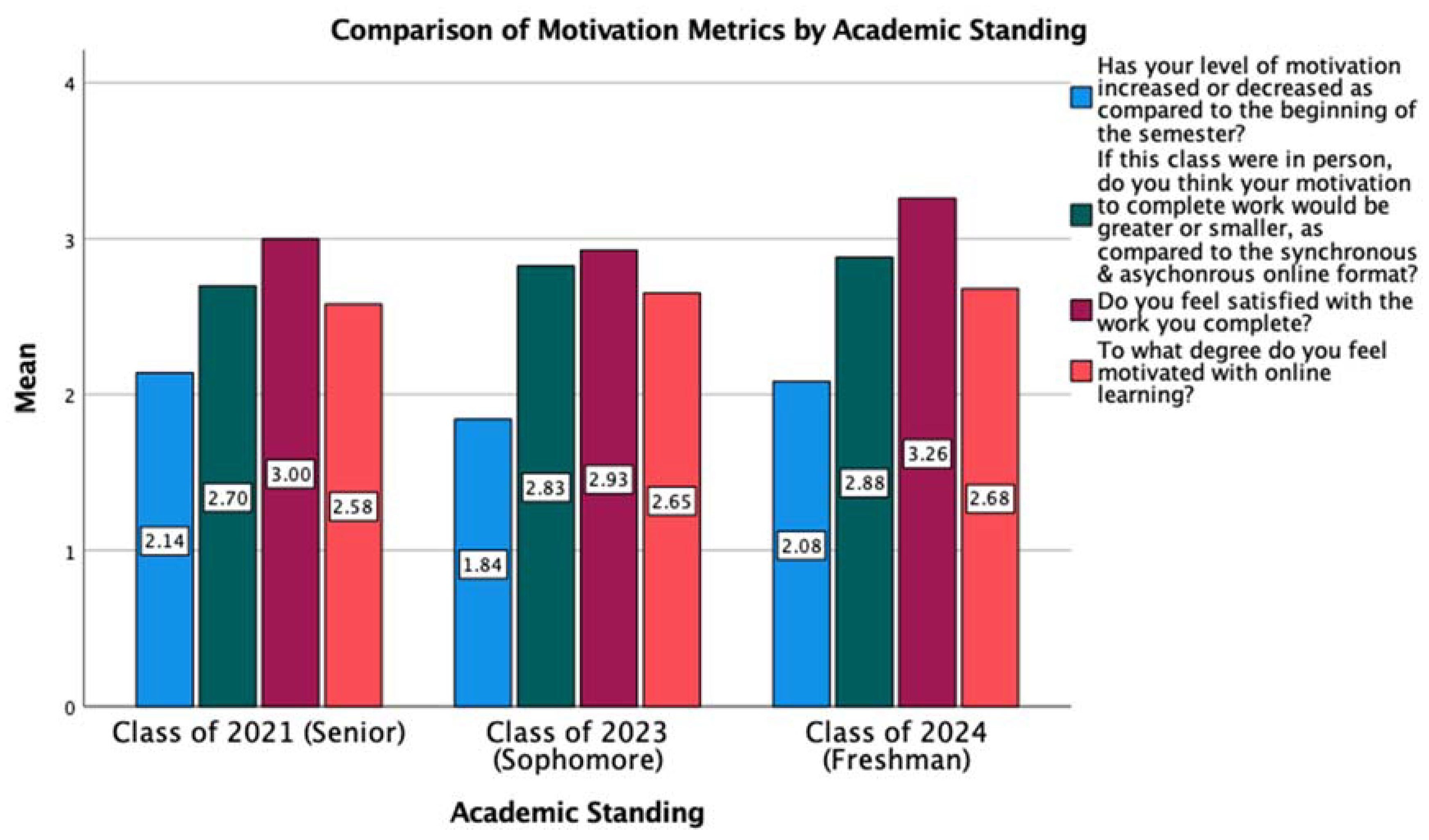

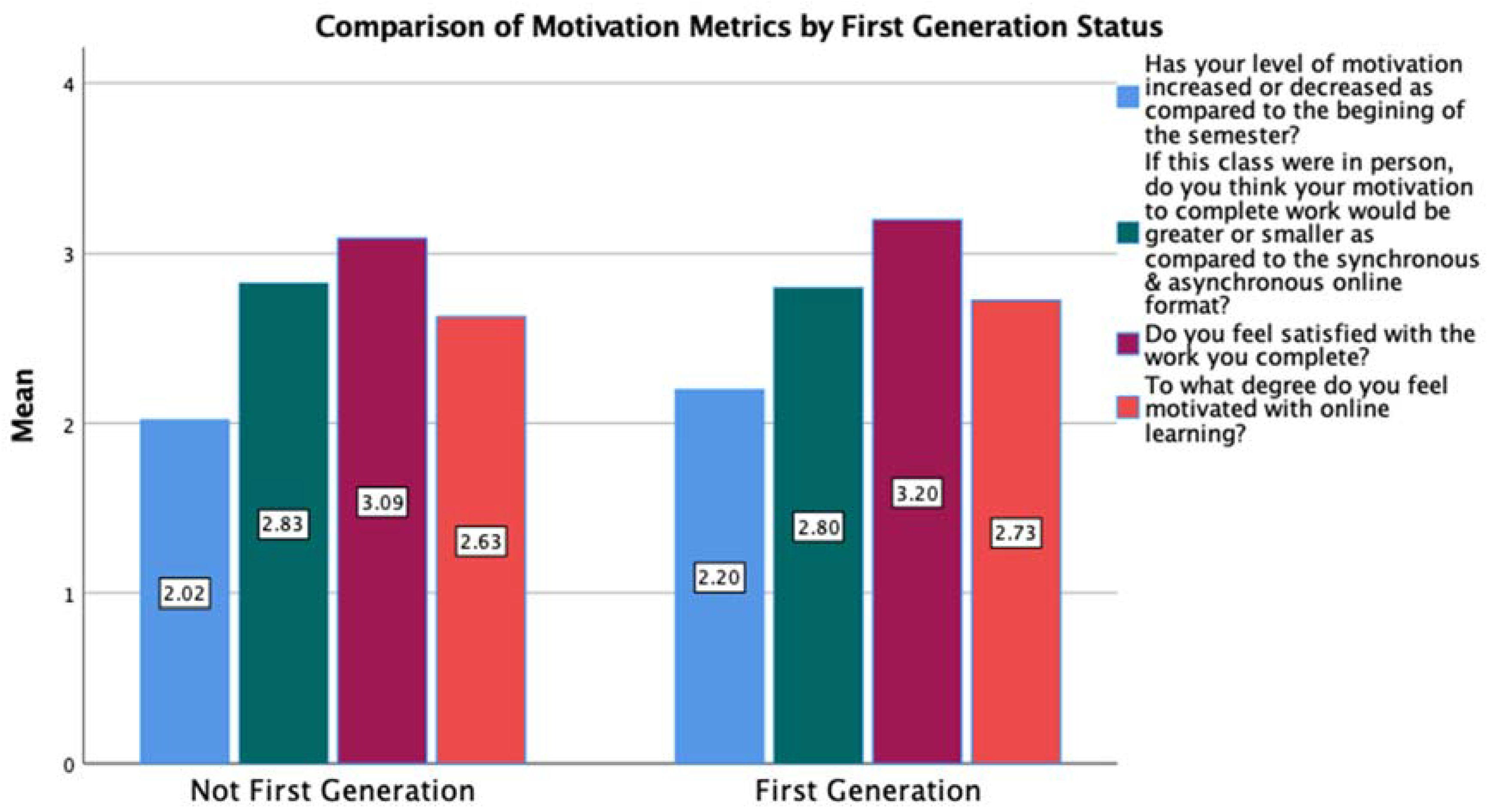
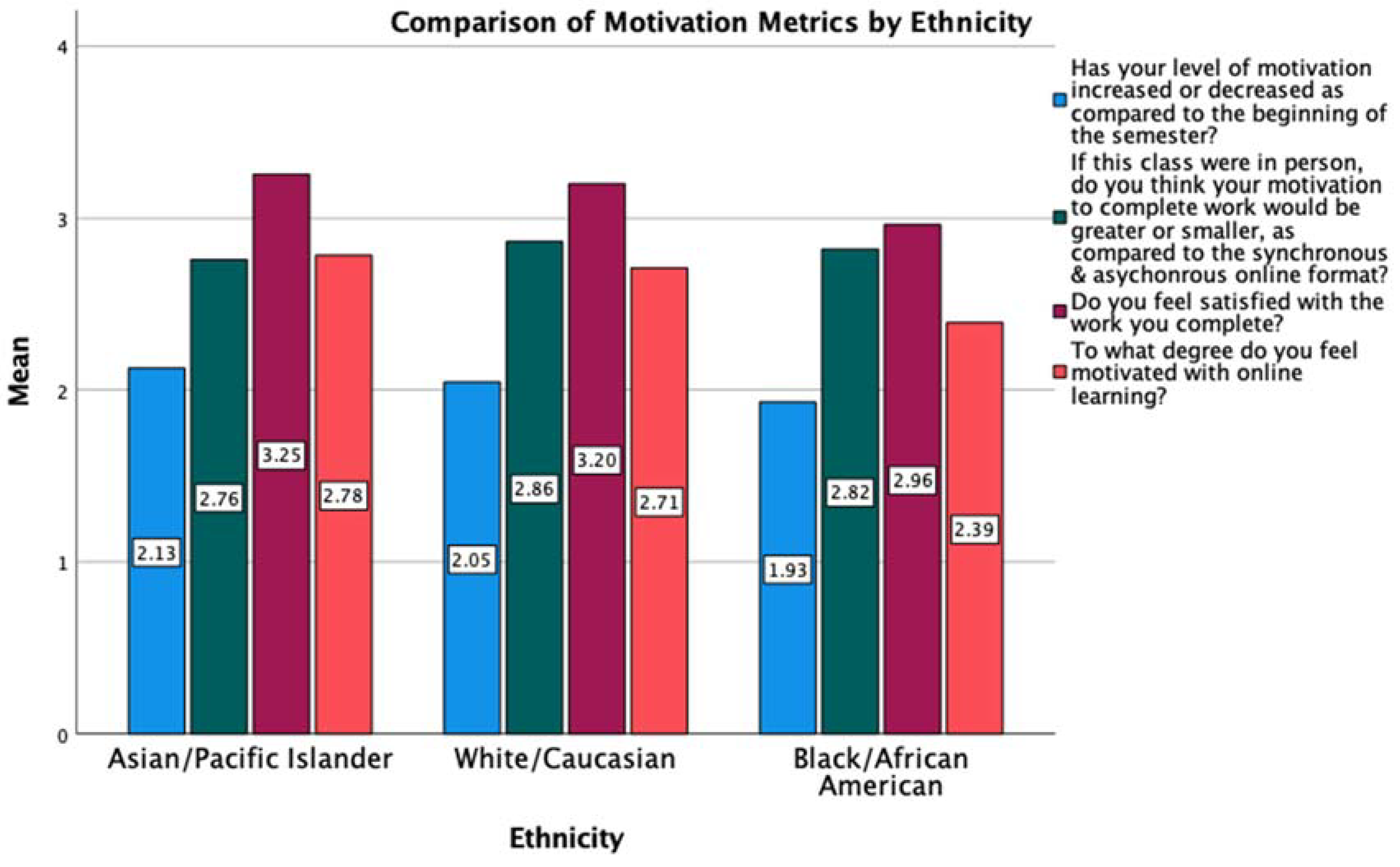

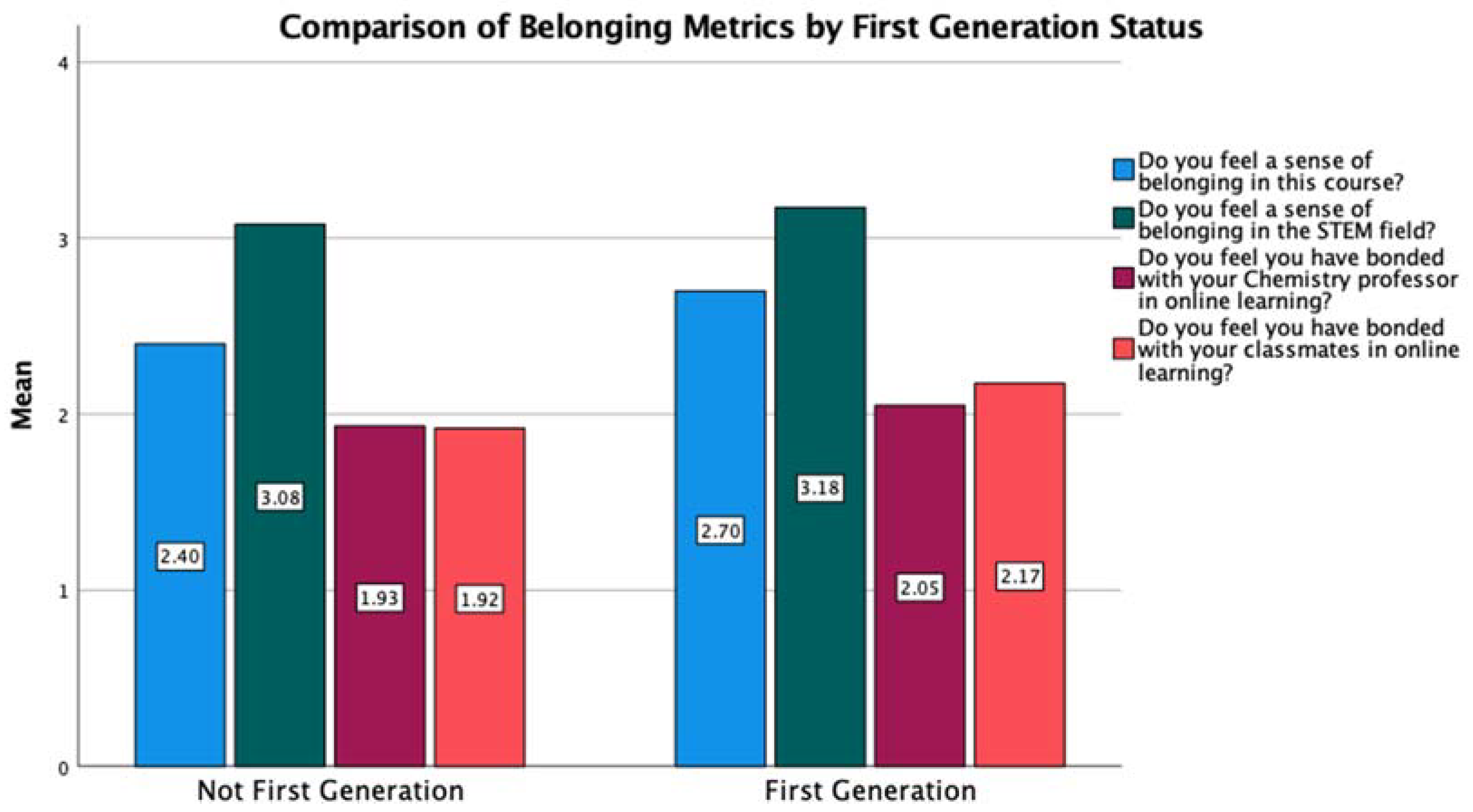

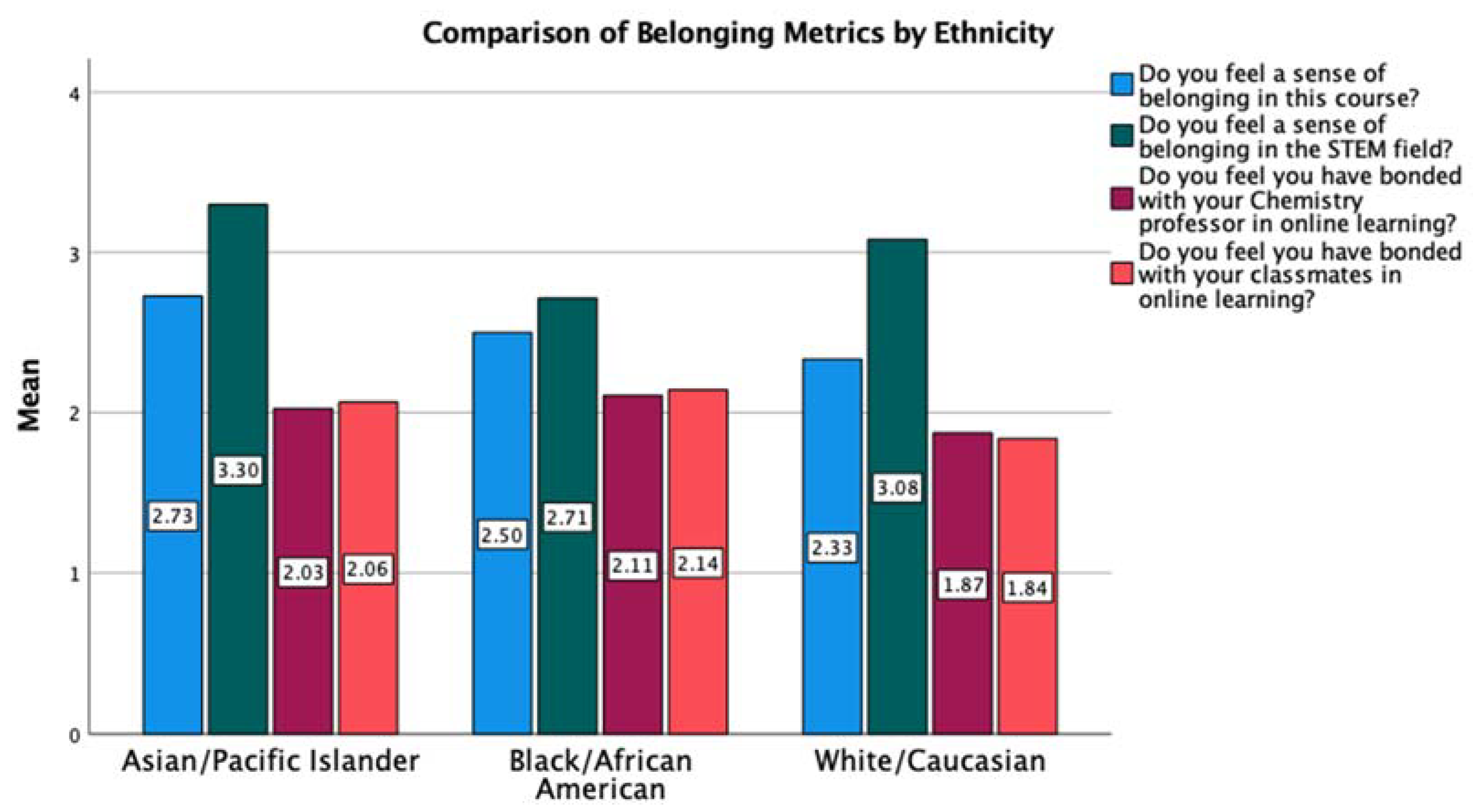


| Demographic | Identification |
|---|---|
| Gender | Male (N = 100) Female (N = 182) Nonbinary (N = 1) |
| Ethnicity | Asian/Pacific Islander (N = 81) White/Caucasian (N = 144) Black/African (N = 33) Hispanic/Latinx (N = 16) American Indian (N = 4) Other (N = 4) More Than One Race (N = 40) |
| Socioeconomic Status | First Generation/Low Income (N = 40) Not First Generation/Low Income (N = 242) |
| Academic Standing | Freshman/First Year (N = 144) Sophomore/Second Year (N = 69) Junior/Third Year (N = 26) Senior/Fourth Year (N = 43) |
| Status | Domestic (N = 274) International (N = 9) |
| Question | Survey Scale | |
|---|---|---|
| To what degree do you feel motivated with online learning? | No motivation (1) Little motivation (2) Moderate motivation (3) Strong motivation (4) | 2.6 |
| Has your level of motivation increased or decreased as compared to the beginning of the semester? | Greatly decreased (1) Somewhat decreased (2) Neither decreased nor increased (3) Somewhat increased (4) Greatly increased (5) | 2.0 |
| Do you feel satisfied with the work you complete? | Extremely dissatisfied (1) Somewhat dissatisfied (2) Neither satisfied nor dissatisfied (3) Somewhat satisfied (4) Extremely satisfied (5) | 3.1 |
| If this class were in person, do you think your motivation to complete work would be greater or smaller, as compared to the synchronous/asynchronous online format? | Greater (3) No change (2) Smaller (1) | 2.3 |
| Question | Demographic Comparison by Academic Standing |
|---|---|
| To what degree do you feel motivated with online learning? | Freshman and Sophomore (tcalc = 0.219, tcrit = 1.97, p = 0.83) Freshman and Senior (tcalc = 0.671, tcrit = 1.97, p = 0.53) Sophomore and Senior (tcalc = 0.389, tcrit = 1.98, p = 0.70) |
| Has your level of motivation increased or decreased as compared to the beginning of the semester? | Freshman and Sophomore (tcalc = 2.01, tcrit = 1.97, p = 0.045) * Freshman and Senior (tcalc = 0.398, tcrit = 1.97, p = 0.69) Sophomore and Senior (tcalc = 1.66, tcrit = 1.98, p = 0.10) |
| Do you feel satisfied with the work you complete? | Freshman and Sophomore (tcalc = 2.13, tcrit = 1.97, p = 0.034) * Freshman and Senior (tcalc = 1.40, tcrit = 1.97, p = 0.16) Sophomore and Senior (talc = 0.34, tcrit = 1.98, p = 0.73) |
| If this class were in person, do you think your motivation to complete work would be greater or smaller, as compared to the synchronous/asynchronous online format? | Freshman and Sophomore (tcalc = 2.27, tcrit = 1.97, p = 0.024) * Freshman and Senior (tcalc = 0.63, tcrit = 1.97, p = 0.53) Sophomore and Senior (tcalc = 2.17, p = 1.98, p = 0.032) * |
| Question | Demographic Comparison by First-Generation Status and Gender |
|---|---|
| To what degree do you feel motivated with online learning? | Male and Female (tcalc = 2.36, tcrit = 1.97, p = 0.019) * First Gen/Low-Income and Non-First-Gen/Low-Income (tcalc = 0.63, tcrit = 1.97, p = 0.53) |
| Has your level of motivation increased or decreased as compared to the beginning of the semester? | Male and Female (tcalc = 2.25, tcrit = 1.97, p = 0.025) * First Gen/Low-Income and Non-First-Gen/Low-Income (tcalc = 1.22, tcrit = 1.97, p = 0.22) |
| Do you feel satisfied with the work you complete? | Male and Female (tcalc = 2.82, tcrit = 1.97, p = 0.0051) * First Gen/Low-Income and Non-First-Gen/Low-Income (talc = 0.59, tcrit = 1.97, p = 0.55) |
| If this class were in person, do you think your motivation to complete work would be greater or smaller, as compared to the synchronous/asynchronous online format? | Male and Female (tcalc = 1.848, tcrit = 1.97, p = 0.066) First Gen/Low-Income and Non-First-Gen/Low-Income (tcalc = 0.32, tcrit = 1.97, p = 0.75) |
| Question | Demographic Comparison by Ethnicity |
|---|---|
| To what degree do you feel motivated with online learning? | Asian/Pacific Islander and Black/African (tcalc = 2.19, tcrit = 1.98, p = 0.030) * Asian/Pacific Islander and White/Caucasian ((tcalc = 1.36, tcrit = 1.97, p = 0.18) Black/African and White/Caucasian (tcalc = 1.24, tcrit = 1.97, p = 0.21)) |
| Has your level of motivation increased or decreased as compared to the beginning of the semester? | Asian/Pacific Islander and Black/African (tcalc = 1.55, tcrit = 1.98, p = 0.125) Asian/Pacific Islander and White/Caucasian (tcalc = 0.56, tcrit = 1.97, p = 0.576) Black/African and White/Caucasian (tcalc = 1.28, tcrit = 1.97, p = 0.204) |
| Do you feel satisfied with the work you complete? | Asian/Pacific Islander and Black/African (tcalc = 1.43, tcrit = 1.98, p = 0.15) Asian/Pacific Islander and White/Caucasian (tcalc = 1.27, tcrit = 1.97, p = 0.21) Black/African and White/Caucasian (tcalc = 0.53, tcrit = 1.97, p = 0.597) |
| If this class were in person, do you think your motivation to complete work would be greater or smaller, as compared to the synchronous/asynchronous online format? | Asian/Pacific Islander and Black/African (tcalc= 0.91, tcrit = 1.98, p = 0.37) Asian/Pacific Islander and White/Caucasian (tcalc= 1.78, tcrit = 1.97, p = 0.078) Black/African and White/Caucasian (tcalc= 0.18, tcrit = 1.97, p = 0.86) |
| Question | Survey Scale | |
|---|---|---|
| Do you feel you have bonded with your Chemistry professor in online learning? | Definitely yes (4) Probably yes (3) Probably not (2) Definitely not (1) | 2.0 |
| Do you feel you have bonded with your classmates in online learning? | Definitely yes (4) Probably yes (3) Probably not (2) Definitely not (1) | 2.0 |
| Do you feel a sense of belonging in this course? | Definitely yes (4) Probably yes (3) Probably not (2) Definitely not (1) | 2.4 |
| Do you feel a sense of belonging in STEM? | Definitely yes (4) Probably yes (3) Probably not (2) Definitely not (1) | 3.1 |
| Question | Demographic Comparison by Academic Standing |
|---|---|
| Do you feel a sense of belonging in the course? | Freshman and Sophomore (tcalc = 1.53, tcrit = 1.97, p = 0.13) Freshman and Senior (tcalc = 0.97, tcrit = 1.97, p = 0.332) Sophomore and Senior (tcalc = 0.28, tcrit = 1.98, p = 0.78) |
| Do you feel you bonded with your classmates in online learning? | Freshman and Sophomore (tcalc = 1.36, tcrit = 1.97, p = 0.17) Freshman and Senior (tcalc = 0.946, tcrit = 1.97, p = 0.35) Sophomore and Senior (tcalc = 1.96, tcrit = 1.98, p = 0.052) |
| Do you feel you have bonded with your chemistry professor in online learning? | Freshman and Sophomore (tcalc= 0.61, tcrit = 1.97, p = 0.54) Freshman and Senior (tcalc= 2.14, tcrit = 1.97, p = 0.034) * Sophomore and Senior (tcalc= 1.39, tcrit = 1.98, p = 0.16) |
| Do you feel a sense of belonging in the STEM field? | Freshman and Sophomore (tcalc = 1.86, tcrit = 1.97, p = 0.064) Freshman and Senior (tcalc = 0.852, tcrit = 1.97, p = 0.395) Sophomore and Senior (tcalc = 0.647, tcrit = 1.98, p = 0.519) |
| Question | Demographic Comparison by First-Generation Status and Gender |
|---|---|
| Do you feel a sense of belonging in the course? | Male and Female (tcalc = 2.72, tcrit = 1.97, p = 0.0070) * First Gen/Low-Income and Non-First (tcalc = 1.89, tcrit = 1.97, p = 0.059) |
| Do you feel you bonded with your classmates in online learning? | Male and Female (tcalc = 0.406, tcrit = 1.97, p = 0.685) First Gen/Low-Income and Non-First-Gen/Low-Income (tcalc = 1.76, tcrit = 1.97, p = 0.080) |
| Do you feel you have bonded with your chemistry professor in online learning? | Male and Female (tcalc = 0.39, tcrit = 1.97, p = 0.70) First Gen/Low-Income and Non-First-Gen/Low-Income (tcalc = 0.83, tcrit = 1.97, p = 0.40) |
| Do you feel a sense of belonging in the STEM field? | Male and Female (tcalc 4.27, tcrit = 1.97, p = 0.00003) * First Gen/Low-Income and Non-First-Gen/Low-Income (tcalc = 0.61, tcrit = 1.97, p = 0.53) |
| Question | Demographic Comparison by Ethnicity |
|---|---|
| Do you feel a sense of belonging in the course? | Asian/Pacific Islander and Black/African (tcalc = 1.45, tcrit = 1.98, p = 0.15) Asian/Pacific Islander and White/Caucasian (tcalc = 3.32, tcrit = 1.97, p = 0.0010) * Black/African and White/Caucasian (tcalc = 0.80 tcrit = 1.97, p = 0.43) |
| Do you feel you bonded with your classmates in online learning? | Asian/Pacific Islander and Black/African (tcalc = 0.54, tcrit = 1.98, p = 0.59) Asian/Pacific Islander and White/Caucasian (tcalc = 1.966, tcrit = 1.97, p = 0.0505) Black/African and White/Caucasian (tcalc = 1.96, tcrit = 1.97, p = 0.052) |
| Do you feel you have bonded with your chemistry professor in online learning? | Asian/Pacific Islander and Black/African (tcalc = 0.033, tcrit = 1.98, p = 0.973) Asian/Pacific Islander and White/Caucasian (tcalc = 1.12, tcrit = 1.97, p = 0.26) Black/African and White/Caucasian (tcalc = 0.820, tcrit = 1.97, p = 0.41) |
| Do you feel a sense of belonging in the STEM field? | Asian/Pacific Islander and Black/African (tcalc = 3.38, tcrit = 1.98, p = 0.00098) * Asian/Pacific Islander and White/Caucasian (tcalc = 2.42, tcrit = 1.97, p = 0.016) * Black/African and White/Caucasian (tcalc = 1.45, tcrit = 1.97, p = 0.15) |
Publisher’s Note: MDPI stays neutral with regard to jurisdictional claims in published maps and institutional affiliations. |
© 2021 by the authors. Licensee MDPI, Basel, Switzerland. This article is an open access article distributed under the terms and conditions of the Creative Commons Attribution (CC BY) license (https://creativecommons.org/licenses/by/4.0/).
Share and Cite
Cox, C.T., Jr.; Stepovich, N.; Bennion, A.; Fauconier, J.; Izquierdo, N. Motivation and Sense of Belonging in the Large Enrollment Introductory General and Organic Chemistry Remote Courses. Educ. Sci. 2021, 11, 549. https://doi.org/10.3390/educsci11090549
Cox CT Jr., Stepovich N, Bennion A, Fauconier J, Izquierdo N. Motivation and Sense of Belonging in the Large Enrollment Introductory General and Organic Chemistry Remote Courses. Education Sciences. 2021; 11(9):549. https://doi.org/10.3390/educsci11090549
Chicago/Turabian StyleCox, Charles T., Jr., Nicole Stepovich, Alexandra Bennion, Jessie Fauconier, and Nicole Izquierdo. 2021. "Motivation and Sense of Belonging in the Large Enrollment Introductory General and Organic Chemistry Remote Courses" Education Sciences 11, no. 9: 549. https://doi.org/10.3390/educsci11090549
APA StyleCox, C. T., Jr., Stepovich, N., Bennion, A., Fauconier, J., & Izquierdo, N. (2021). Motivation and Sense of Belonging in the Large Enrollment Introductory General and Organic Chemistry Remote Courses. Education Sciences, 11(9), 549. https://doi.org/10.3390/educsci11090549







